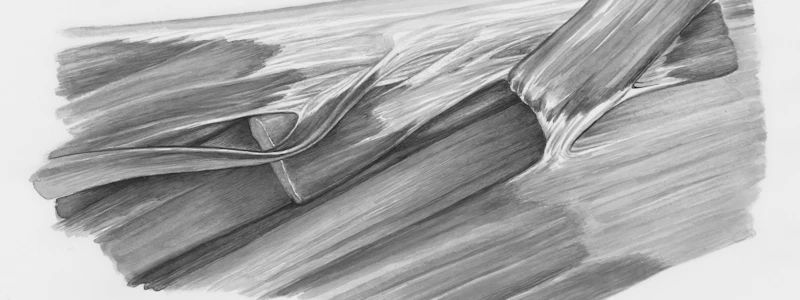Podcast
Questions and Answers
What is a primary characteristic of skeletal muscles?
What is a primary characteristic of skeletal muscles?
- They primarily use carbohydrates for energy.
- They are striated and work in pairs. (correct)
- They are elastic and work independently.
- They are non-striated and involuntary.
Which type of muscle is most likely to be found lining hollow organs?
Which type of muscle is most likely to be found lining hollow organs?
- Skeletal muscle
- Smooth muscle (correct)
- Striated muscle
- Cardiac muscle
How do smooth muscles primarily obtain their energy?
How do smooth muscles primarily obtain their energy?
- From aerobic respiration
- From electrical impulses only
- From carbohydrates (correct)
- From a lack of oxygen
Which type of muscle fibers contract more slowly and have better blood supply?
Which type of muscle fibers contract more slowly and have better blood supply?
What type of activity are fast, white muscle fibers primarily associated with?
What type of activity are fast, white muscle fibers primarily associated with?
What best describes the contraction speed of smooth muscles relative to skeletal muscles?
What best describes the contraction speed of smooth muscles relative to skeletal muscles?
Which type of muscle is under voluntary control?
Which type of muscle is under voluntary control?
In which of the following scenarios are skeletal muscles primarily engaged?
In which of the following scenarios are skeletal muscles primarily engaged?
What is the primary function of the epimysium in muscle structure?
What is the primary function of the epimysium in muscle structure?
Which of the following is NOT a function of skeletal muscles?
Which of the following is NOT a function of skeletal muscles?
What layer of connective tissue surrounds each individual muscle fiber?
What layer of connective tissue surrounds each individual muscle fiber?
In which type of muscle control is movement primarily under voluntary control?
In which type of muscle control is movement primarily under voluntary control?
Which of the following statements about muscle fibers is incorrect?
Which of the following statements about muscle fibers is incorrect?
How do tendons facilitate movement of the skeleton?
How do tendons facilitate movement of the skeleton?
Which component of the nervous system stimulates muscle fibers through the connective tissue layers?
Which component of the nervous system stimulates muscle fibers through the connective tissue layers?
What is the primary role of the perimysium in muscle anatomy?
What is the primary role of the perimysium in muscle anatomy?
What is the primary function of smooth muscles?
What is the primary function of smooth muscles?
Which characteristic differentiates cardiac muscle from skeletal muscle?
Which characteristic differentiates cardiac muscle from skeletal muscle?
The 'origin' of a muscle is defined as what?
The 'origin' of a muscle is defined as what?
What is the term for a wide, sheet-like tendon?
What is the term for a wide, sheet-like tendon?
Which of the following statements about the atrioventricular node is true?
Which of the following statements about the atrioventricular node is true?
Which connection is specifically defined as the connection between a muscle and a bone?
Which connection is specifically defined as the connection between a muscle and a bone?
Study Notes
Muscle Fiber Characteristics
- Fibers vary in length and color, ranging from white to deep red.
Functions of Muscles
- Produce skeletal movement by pulling on tendons that move bones.
- Maintain posture and body position, facilitating balance.
- Support soft tissues, particularly in the abdominal wall and pelvic floor.
- Guard entrances and exits of the body via sphincters.
- Maintain body temperature through heat production during contraction.
Composition of Muscle
- Muscles are organs composed of muscle fibers (cells), connective tissue, blood vessels, and nerves.
Connective Tissue Layers
- Epimysium: Encloses the entire muscle.
- Perimysium: Divides muscles into fascicles and contains blood vessels and nerves.
- Endomysium: Encases individual muscle fibers and includes capillaries and nerve tissue.
Muscle Structure
- Muscles consist of fiber groups held by connective tissue, surrounded by a fibrous sheath (fascia).
Muscle Classification
- Voluntary Muscles: Under conscious control; examples include hand movements and walking.
- Involuntary Muscles: Function without conscious control; examples include heart beating and peristalsis in the digestive system.
Types of Muscle
-
Skeletal Muscle:
- Elastic, striated, works in pairs (one flexes while the other extends).
- Stimulated by electrical impulses from the nervous system.
- Fast, white fibers contract rapidly, have poor blood supply, operate anaerobically, and tire quickly.
- Slow, red fibers contract slowly, have better blood supply, operate aerobically, and are used for sustained activities, like posture maintenance.
-
Smooth Muscle:
- Lines internal hollow organs (e.g., intestines, stomach).
- Contracts slower than skeletal muscles and can maintain contraction longer.
- Not as reliant on oxygen and stimulated by electrical impulses or hormones.
-
Cardiac Muscle (Myocardium):
- Striated, smaller, and shorter fibers compared to skeletal muscle.
- Contracts due to impulses from specialized tissue in the heart (sinoatrial and atrioventricular nodes).
Types of Muscle Connections
- Muscle connections can be categorized as:
- Bone-muscle-bone
- Bone-muscle-skin
- Skin-muscle-skin
Muscle Anatomy
- Each muscle comprises three main parts:
- Body: The main portion of the muscle.
- Origin: The fixed attachment point of the muscle.
- Insertion: The point where the muscle attaches to the moving part of the body.
Tendons
- Tendons connect muscles to bones and vary in length.
- A sheet-like tendon is referred to as an aponeurosis.
Studying That Suits You
Use AI to generate personalized quizzes and flashcards to suit your learning preferences.
Related Documents
Description
This quiz explores the various functions of muscles in the human body, including their role in movement, posture maintenance, and temperature regulation. Additionally, it discusses the characteristics of muscle fibers and their structural variations. Test your knowledge on this essential aspect of human anatomy.




